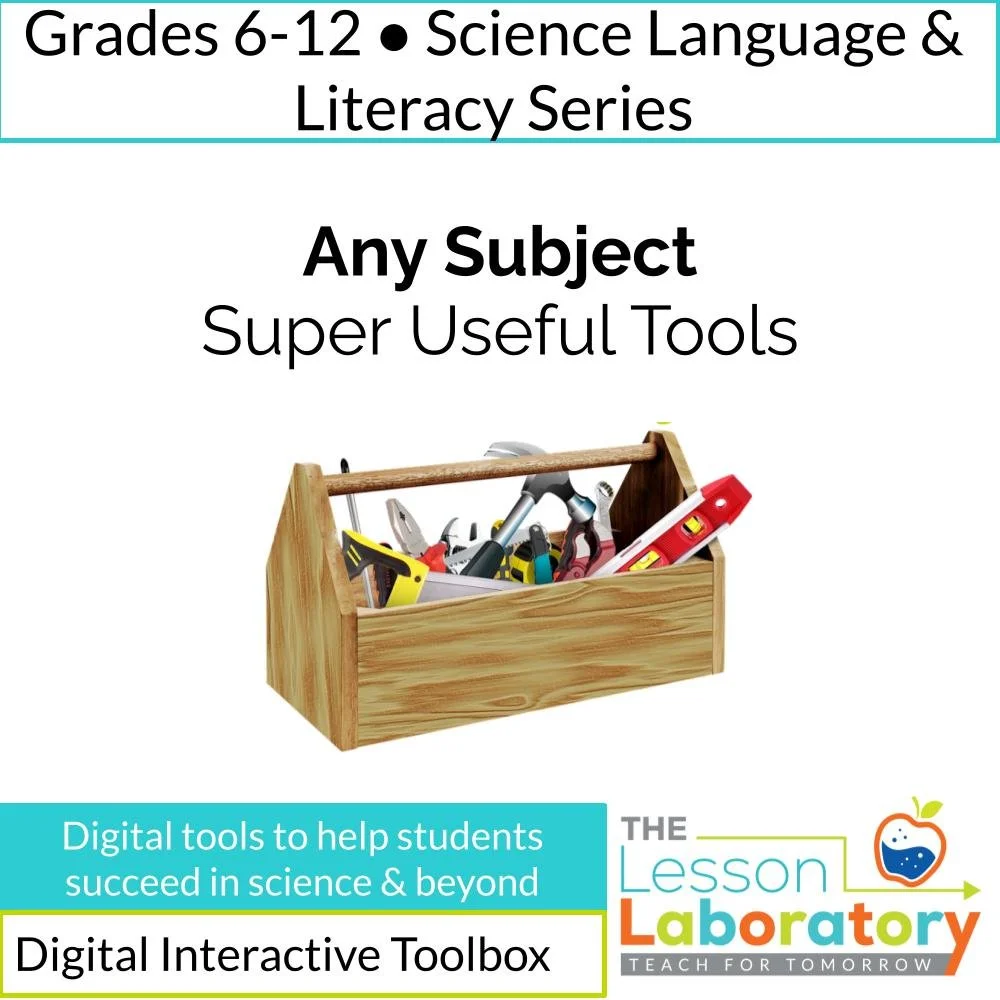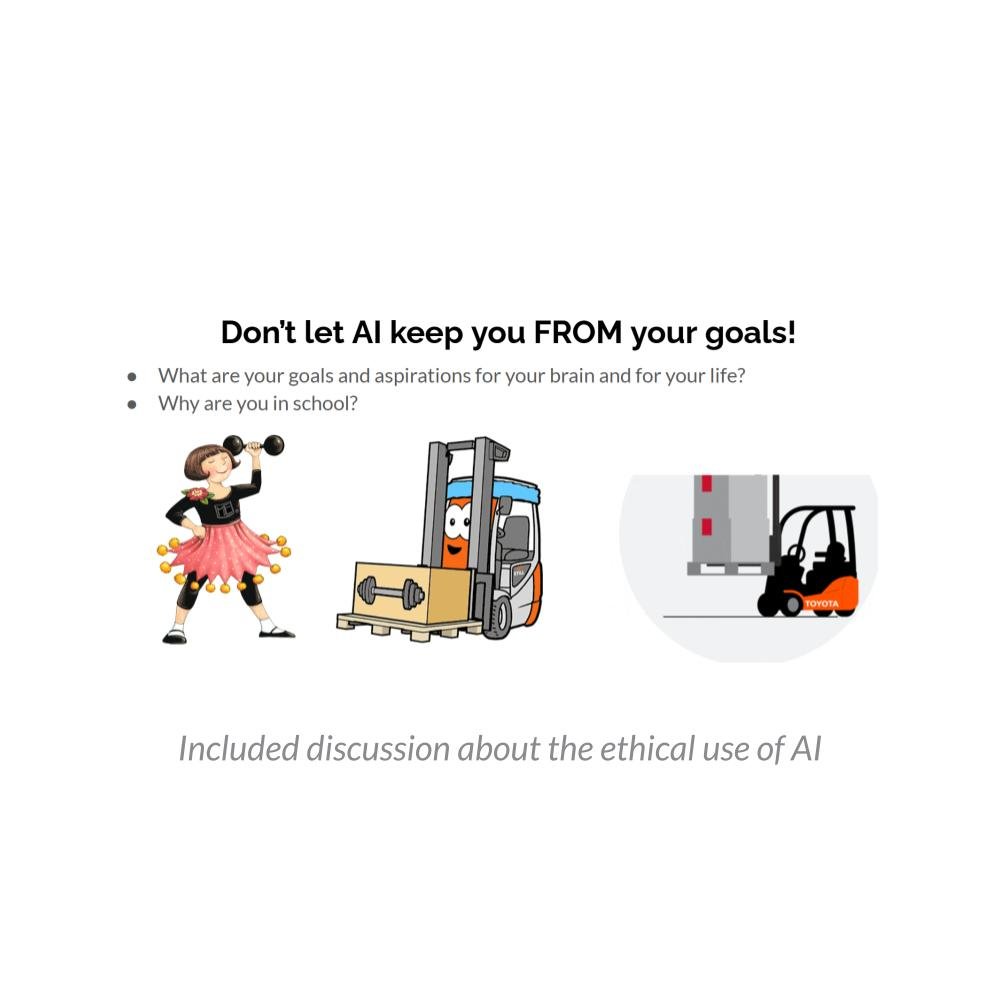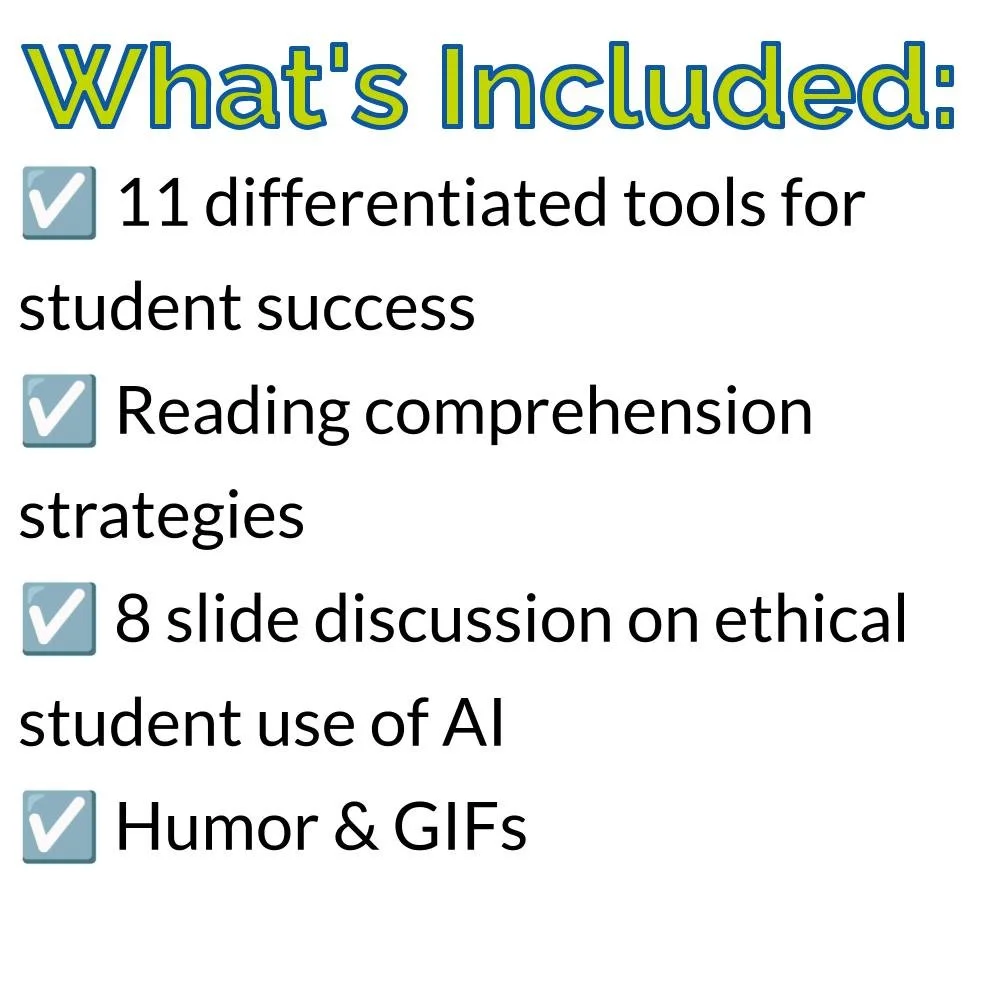



Super Useful Student Tools – Reading, Research, AI Skills & Digital Supports for Any Subject
A Classroom Resource for Digital Tools, AI Use, Reading Strategies & Academic Skill Support.
Unleash the Power of Technological Power tools!
Empower students across all subjects with this dynamic document, a treasure trove of hyperlinked tools designed to revolutionize their learning experience. Each tool is a gateway to unlocking new levels of comprehension and productivity.
Google Translate: Conquer Language Barriers Students can seamlessly traverse language barriers with Google Translate. It's the ultimate weapon for translating between different languages, ensuring that no concept or idea remains out of reach.
Speechnotes: Turn Speech into Text Speechnotes is the magic wand that transforms spoken words into written text. With this tool at their disposal, students can bring their thoughts to life with a single utterance.
Natural Readers: Elevate Accessibility Say goodbye to readability challenges. Natural Readers steps in to make text more accessible, offering dyslexic-friendly fonts and the power to read text aloud. It's a game-changer for every student.
Rewordify: Simplify Complex Text No more wrestling with complex vocabulary. Rewordify swoops in to simplify advanced text, ensuring that students grasp even the most challenging concepts with ease.
Easybib: Master Citations and Bibliographies Citations made easy! With Easybib, students can effortlessly generate accurate research citations. It's the key to proper attribution and creating impeccable bibliographies.
Wordcounter: Refine Your Writing Polish your prose with Wordcounter. Not only does it tally your words, but it also acts as your vigilant grammar and spelling watchdog. It's your secret weapon for impeccable writing.
Give students the tools they need to thrive in any academic arena. This document is a gateway to a world where language barriers dissolve, comprehension soars, and writing reaches new heights of excellence. Don't let them miss out on this transformative learning experience.
Grade & Course Recommendation:
Middle School:Grades 6–8 as a general resource for lab preparation and academic organization.
High School:Grades 9–12 across science courses for supporting study skills, planning, and data organization.
Cross-Curricular Connections:
ELA Integration: Strengthens comprehension and note-taking skills applicable in all subjects.
Career Skills Connection: Supports metacognitive habits used in real research and technical documentation.
Join the Lesson Laboratory and Teach for Tomorrow!
NGSS Alignment for “Any Subject Super Useful Tools”
Relevant Practices (SEPs)
Obtaining, Evaluating, and Communicating Information
Students learn to use tools like Rewordify, Natural Readers, and Wordcounter to process and communicate information effectively.
Asking Questions and Defining Problems
The AI discussion prompts students to reflect on their learning goals and how tools should be used responsibly.
Constructing Explanations and Designing Solutions
By choosing appropriate tools for different tasks, students practice problem-solving.
Engaging in Argument from Evidence
The AI ethics conversation encourages weighing appropriate vs. inappropriate uses with reasoning.
Crosscutting Concepts (CCCs)
Structure and Function – Choosing the right tool for the task (AI vs. traditional learning tools).
Cause and Effect – Considering how the use or misuse of tools (like AI) impacts learning outcomes.
Systems and System Models – Understanding technology as part of the broader learning environment.
Stability and Change – Recognizing that technology and AI are changing rapidly, and adapting learning practices accordingly.
Middle School NGSS Performance Expectations (Broadly Applicable)
MS-ETS1-1: Define the criteria and constraints of a design problem with sufficient precision to ensure a successful solution. (Choosing the right digital tool for a task mirrors this design thinking.)
MS-ETS1-2: Evaluate competing design solutions using a systematic process. (Deciding whether AI or another tool is the most effective for a goal.)
High School NGSS Performance Expectations (Broadly Applicable)
HS-ETS1-2: Design a solution to a complex real-world problem by breaking it down into smaller, more manageable problems. (Selecting tools to manage reading, writing, and research tasks.)
HS-ETS1-3: Evaluate a solution to a complex real-world problem based on prioritized criteria and trade-offs. (Evaluating appropriate vs. inappropriate uses of AI in learning.)
HS-ETS1-4: Use a computer simulation to model the impact of proposed solutions. (AI tools essentially act as simulations/assistants to test learning strategies.)
Common Core Alignment
ELA Standards – Reading & Informational Text
CCSS.ELA-LITERACY.RI.6-12.1 – Cite textual evidence to support analysis of what the text says explicitly. (Students use Rewordify, Natural Readers, or translation tools to understand and analyze texts.)
CCSS.ELA-LITERACY.RI.6-12.7 – Integrate information presented in different media or formats. (Using AI explanations, videos, and text-to-speech tools.)
ELA Standards – Writing
CCSS.ELA-LITERACY.W.6-12.7 – Conduct short research projects to answer a question. (EasyBib, Purdue OWL, and citation generators help with research projects.)
CCSS.ELA-LITERACY.W.6-12.8 – Gather relevant information from multiple sources, assess credibility, and integrate the information while avoiding plagiarism. (Bibliography and citation tools directly address this.)
CCSS.ELA-LITERACY.W.6-12.6 – Use technology, including the Internet, to produce and publish writing. (Wordcounter, AI editing, and other digital tools support this.)
ELA Standards – Speaking & Listening
CCSS.ELA-LITERACY.SL.6-12.1 – Engage effectively in collaborative discussions. (AI use discussion prompts encourage structured classroom dialogue.)
CCSS.ELA-LITERACY.SL.6-12.4 – Present claims and findings clearly and persuasively. (Using AI to generate practice quizzes or study aids strengthens communication of ideas.)
ELA Standards – Language
CCSS.ELA-LITERACY.L.6-12.1 & L.6-12.2 – Demonstrate command of grammar and usage conventions. (Wordcounter helps check grammar and spelling.)
CCSS.ELA-LITERACY.L.6-12.4 – Determine the meaning of unknown words using various strategies. (Rewordify and translation tools support this directly.)
Math Connections
Although not the main focus, some of the tools (scientific notation calculator, periodic table, interactive maps) align with Mathematical Practice Standards (CCSS.MP):
CCSS.MATH.PRACTICE.MP5 – Use appropriate tools strategically. (Choosing the right calculator or online tool for a math/science task.)
CCSS.MATH.PRACTICE.MP6 – Attend to precision. (Ensuring citations, grammar, and calculations are accurate.)
A Classroom Resource for Digital Tools, AI Use, Reading Strategies & Academic Skill Support.
Unleash the Power of Technological Power tools!
Empower students across all subjects with this dynamic document, a treasure trove of hyperlinked tools designed to revolutionize their learning experience. Each tool is a gateway to unlocking new levels of comprehension and productivity.
Google Translate: Conquer Language Barriers Students can seamlessly traverse language barriers with Google Translate. It's the ultimate weapon for translating between different languages, ensuring that no concept or idea remains out of reach.
Speechnotes: Turn Speech into Text Speechnotes is the magic wand that transforms spoken words into written text. With this tool at their disposal, students can bring their thoughts to life with a single utterance.
Natural Readers: Elevate Accessibility Say goodbye to readability challenges. Natural Readers steps in to make text more accessible, offering dyslexic-friendly fonts and the power to read text aloud. It's a game-changer for every student.
Rewordify: Simplify Complex Text No more wrestling with complex vocabulary. Rewordify swoops in to simplify advanced text, ensuring that students grasp even the most challenging concepts with ease.
Easybib: Master Citations and Bibliographies Citations made easy! With Easybib, students can effortlessly generate accurate research citations. It's the key to proper attribution and creating impeccable bibliographies.
Wordcounter: Refine Your Writing Polish your prose with Wordcounter. Not only does it tally your words, but it also acts as your vigilant grammar and spelling watchdog. It's your secret weapon for impeccable writing.
Give students the tools they need to thrive in any academic arena. This document is a gateway to a world where language barriers dissolve, comprehension soars, and writing reaches new heights of excellence. Don't let them miss out on this transformative learning experience.
Grade & Course Recommendation:
Middle School:Grades 6–8 as a general resource for lab preparation and academic organization.
High School:Grades 9–12 across science courses for supporting study skills, planning, and data organization.
Cross-Curricular Connections:
ELA Integration: Strengthens comprehension and note-taking skills applicable in all subjects.
Career Skills Connection: Supports metacognitive habits used in real research and technical documentation.
Join the Lesson Laboratory and Teach for Tomorrow!
NGSS Alignment for “Any Subject Super Useful Tools”
Relevant Practices (SEPs)
Obtaining, Evaluating, and Communicating Information
Students learn to use tools like Rewordify, Natural Readers, and Wordcounter to process and communicate information effectively.
Asking Questions and Defining Problems
The AI discussion prompts students to reflect on their learning goals and how tools should be used responsibly.
Constructing Explanations and Designing Solutions
By choosing appropriate tools for different tasks, students practice problem-solving.
Engaging in Argument from Evidence
The AI ethics conversation encourages weighing appropriate vs. inappropriate uses with reasoning.
Crosscutting Concepts (CCCs)
Structure and Function – Choosing the right tool for the task (AI vs. traditional learning tools).
Cause and Effect – Considering how the use or misuse of tools (like AI) impacts learning outcomes.
Systems and System Models – Understanding technology as part of the broader learning environment.
Stability and Change – Recognizing that technology and AI are changing rapidly, and adapting learning practices accordingly.
Middle School NGSS Performance Expectations (Broadly Applicable)
MS-ETS1-1: Define the criteria and constraints of a design problem with sufficient precision to ensure a successful solution. (Choosing the right digital tool for a task mirrors this design thinking.)
MS-ETS1-2: Evaluate competing design solutions using a systematic process. (Deciding whether AI or another tool is the most effective for a goal.)
High School NGSS Performance Expectations (Broadly Applicable)
HS-ETS1-2: Design a solution to a complex real-world problem by breaking it down into smaller, more manageable problems. (Selecting tools to manage reading, writing, and research tasks.)
HS-ETS1-3: Evaluate a solution to a complex real-world problem based on prioritized criteria and trade-offs. (Evaluating appropriate vs. inappropriate uses of AI in learning.)
HS-ETS1-4: Use a computer simulation to model the impact of proposed solutions. (AI tools essentially act as simulations/assistants to test learning strategies.)
Common Core Alignment
ELA Standards – Reading & Informational Text
CCSS.ELA-LITERACY.RI.6-12.1 – Cite textual evidence to support analysis of what the text says explicitly. (Students use Rewordify, Natural Readers, or translation tools to understand and analyze texts.)
CCSS.ELA-LITERACY.RI.6-12.7 – Integrate information presented in different media or formats. (Using AI explanations, videos, and text-to-speech tools.)
ELA Standards – Writing
CCSS.ELA-LITERACY.W.6-12.7 – Conduct short research projects to answer a question. (EasyBib, Purdue OWL, and citation generators help with research projects.)
CCSS.ELA-LITERACY.W.6-12.8 – Gather relevant information from multiple sources, assess credibility, and integrate the information while avoiding plagiarism. (Bibliography and citation tools directly address this.)
CCSS.ELA-LITERACY.W.6-12.6 – Use technology, including the Internet, to produce and publish writing. (Wordcounter, AI editing, and other digital tools support this.)
ELA Standards – Speaking & Listening
CCSS.ELA-LITERACY.SL.6-12.1 – Engage effectively in collaborative discussions. (AI use discussion prompts encourage structured classroom dialogue.)
CCSS.ELA-LITERACY.SL.6-12.4 – Present claims and findings clearly and persuasively. (Using AI to generate practice quizzes or study aids strengthens communication of ideas.)
ELA Standards – Language
CCSS.ELA-LITERACY.L.6-12.1 & L.6-12.2 – Demonstrate command of grammar and usage conventions. (Wordcounter helps check grammar and spelling.)
CCSS.ELA-LITERACY.L.6-12.4 – Determine the meaning of unknown words using various strategies. (Rewordify and translation tools support this directly.)
Math Connections
Although not the main focus, some of the tools (scientific notation calculator, periodic table, interactive maps) align with Mathematical Practice Standards (CCSS.MP):
CCSS.MATH.PRACTICE.MP5 – Use appropriate tools strategically. (Choosing the right calculator or online tool for a math/science task.)
CCSS.MATH.PRACTICE.MP6 – Attend to precision. (Ensuring citations, grammar, and calculations are accurate.)